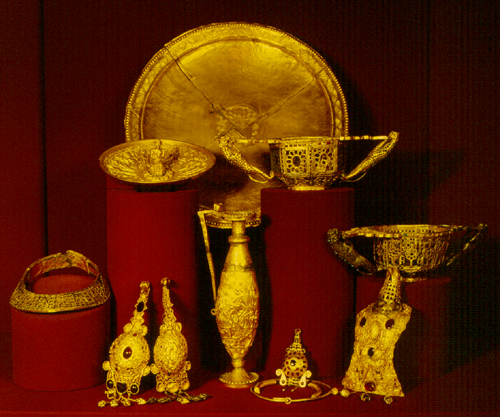Russian ambassador: Politicians should leave historians to rule on Romania's missing treasure


A commission of Romanian and Russian historians will meet in March 2013 to discuss Romania's national treasure, which, according to some Romanian officials, is in Moscow. The Russian Ambassador to Bucharest Oleg Malghinov however said there isn't anyone qualified to certify that the treasure still exists and is in Moscow. In a recent TV show in Romania, the Ambassador said the fact that the whole discussion had become political does not help, and that historians should be left to solve the problem.
He also argued that Romania's attempt to include recovering its treasure and discussion with Russia as part of a European Commission resolution is not the right way to approach the issue. “Historical issues are very complex [..]. I don't think that there is anyone sufficiently qualified to say whether the treasure exists or not,” said the Russian Ambassador.
Romania's Foreign Affairs Minister Titus Corlatean said earlier in October that Romania's treasure is definitely in Moscow, and recovering it is a priority for the ministry he leads, but the chances of this happening rely on a functional political dialogue with the Russian Federation. In 2017, it will have been 100 years since Romania's treasure was sent to Moscow, the Romanian Minister said. “There were some small gestures from the Big Brother at the time, the Soviet Union, which sent some of the pieces of treasure back to Bucharest, which provided confirmation of its existence and presence in Russia, should we have needed another one,” said Corlatean.
Romania sent its treasure to Russia during the First World War, to protect it from the army of the Central Powers, which had occupied a large part of Romania. After the Russian revolution and the installation of communism, the treasure was never fully returned. Romania received three different lots, in 1935, 1956 and 2008, containing some of the objects in the treasure, but most of it remained outside Romania, turning it into a sensitive issue between Romania and Russia.
The treasure included 93 tonnes of gold, most of which was gold coins from individuals, companies and private banks in Romania, and 2.4 tonnes of gold bullion, belonging to the Romanian Central Bank (BNR). It also included documents, manuscripts, old coins, paintings, rare books, church objects and collections, as well as public effects and various valuables. The Russian Empire at the time signed only with the Romanian Central Bank, and not with the owners of the goods, who had deposited them with BNR.
A first tranche of the treasure, including mostly the rare objects, documents, manuscripts, but none of the gold objects, was made in 1935. A second tranche, including the Pietroasele treasure (in picture), with 22 gold objects, as well as painting by Nicolae Grigorescu, jewelry, some gold coins and medals was sent back in 1956. In the early 90s, when Romania was no longer a communist country, Russia's response was that there was not a treasure problem anymore, as it had been solved in 1956. In 2008, in an attempt to recover the remainder, Romania received an extra 12 gold coins from Russia. Earlier in 2003, a commission of historians was set up to study the issue, after Russia refused to include the treasure in the friendship treaty signed the same year.
editor@romania-insider.com
(photo source: Wikipedia)












